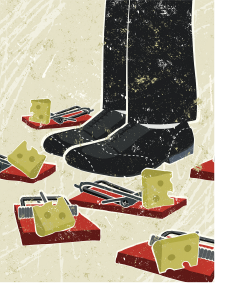 The potential for damage from corporate reputational crises is greater than ever, with market cap, sales, margins, and profits all in danger. But in today's heated social media environment—in which the public and key stakeholder groups seem all too ready to personalize their criticism and affix blame on individuals—CEOs are now personally at great risk.
The potential for damage from corporate reputational crises is greater than ever, with market cap, sales, margins, and profits all in danger. But in today's heated social media environment—in which the public and key stakeholder groups seem all too ready to personalize their criticism and affix blame on individuals—CEOs are now personally at great risk.
Professional risk managers—whatever their positions—need to understand that traditional executive liability solutions are ineffective for these new risks. They need to be able to advise company leadership on new tools available to deter attacks and to insulate their clients when attacks do occur.
Reputational Risk Evolution
In the past, companies had to worry only about the direct financial consequences of workplace accidents, lawsuits, or investigations; officers and directors felt secure with traditional D&O policies; and brand executives were skilled at deploying the full spectrum of marketing tactics.
Now, the nature of reputational risk is different. A firestorm may ignite as the result of a factual incident—or it may simply be a case of “fake news” circulating on social media. The speed with which lasting damage can occur is daunting, and reputations can be damaged—with consequential financial losses—rapidly and substantially.
A recent study by Steel City Re, which analyzes reputational risk and provides insurance products to protect companies and their leadership, found that financial losses related to reputational attacks have increased by over 400 percent in the past five years, a trend which continues to rise.
This same study also found an increase in public anger and a preference for stakeholders to direct their frustration toward individuals, namely CEOs and board members. Directors, feeling the heat from activist investors and other stakeholders, are increasingly looking toward what they believe is a more appropriate target: their CEOs.
Consider these points, embodied by a recent Wall Street Journal headline: “Activist Investors Have a New Bloodlust: CEOs.”
- The turnover rate among CEOs is increasing. In 2016, according to SpencerStuart, 58 of the S&P 500's CEOs transitioned, although not all were pushed out following crises. That is the highest number since 2006, a 13 percent increase over 2015 and a 57 percent increase over 2012.
- Fewer CEOs are chairing boards. According to data analytics firm Equilar, among S&P 500 companies, 35.1 percent now have a non-executive chairman, up from 27.7 percent in 2012.
- While strong companies and brands tend to recover quickly, individual reputations do not. When a CEO is forced out of that position, with related attempts to claw back compensation, the reputational damage affects his or her career and earning capacity for years to come.
Proper Protection
Protecting against these risks is now crucial, and new tools are presenting themselves that can provide that protection. These tactics include:
- Pre-emptively using third-party endorsements and warranties, in the form of new insurance products that both validate the strong governance measures being undertaken and protect against the downside of unpredictable attacks. Such products make it less likely that an attack will occur and provide a credible built-in defense if they do.
- Strategically creating a record of good governance that allows individuals in leadership to respond quickly and effectively when attacked personally. The development of a positive story line as an alternative to whatever criticism may surface may get directors the benefit of the doubt, at least among some stakeholders.
- Providing resources to compensate corporate leaders in the event all other strategies fail and financial losses are unavoidable.
Companies and executives have long assumed that if they practice good governance and adopt best-in-class systems, their reputations would be secure. The same could have been said a generation ago of companies and their directors and officers in the pre-D&O insurance era. That generation learned that dutifully doing the right thing doesn't always prevent lawsuits.
This generation of corporate leaders is learning the same lesson with respect to reputation. The damage now is being done in the court of public opinion, but it happens faster, is more personal, and as real as the damages in any litigation. Prudent risk managers and their advisors need to employ all the tools available to protect them.
© 2025 ALM Global, LLC, All Rights Reserved. Request academic re-use from www.copyright.com. All other uses, submit a request to [email protected]. For more information visit Asset & Logo Licensing.




